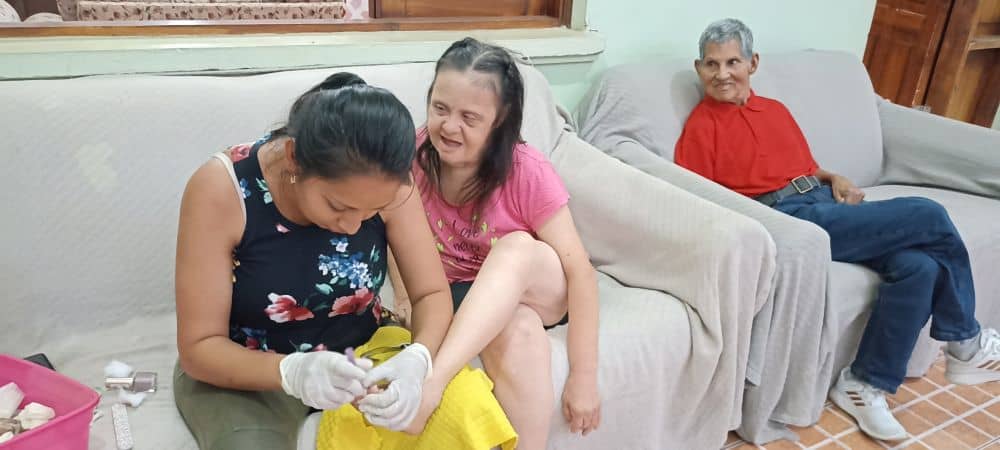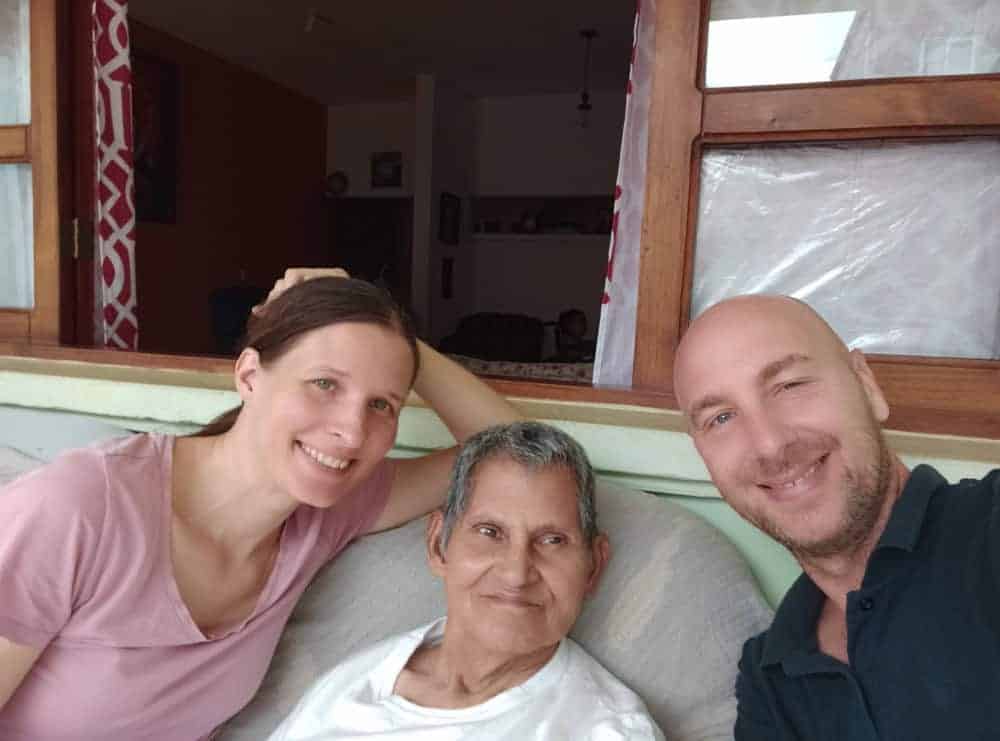Nowhere can you feel the family atmosphere more than at the table.
In communities like this one in Arc, the table in the dining room has always represented the center, the most important place in the community’s life —more important than a workshop, room, or any other living space.
A family that eats together stays together.
At the table, especially during the main daily meals of breakfast, lunch, and dinner, bonds between people who live together are shown and strengthened.
Arc’s table in Isabel’s house, where we live, actually consists of two large, elongated wooden tables.
It is large enough that thirteen members, sometimes even more, can dine next to it every day. During the week, when the boys and girls work in the workshops, they have lunch in the workshop house, so we are only together for breakfast and dinner. During the weekend, of course, we have all three meals together.

Lavarse las manos
The sign that we are about to eat is the same at all meals. The assistant, who is preparing the meal and already distributing the food on the plates, announces what the boys and girls are most eagerly waiting for:
‘Lavarse las manos.’ (Wash the hands)
He doesn’t even have to shout. This is the magic phrase Darwin answers first.
As soon as he hears it, he jumps out of his chair and shouts at the top of his voice (always the same):
‘Hector, las manos, las manos’, (Hector, hands, hands).

Darwin always calls Hector first. That’s how he got used to it. Hector is usually somewhere far away because he works slowly and is always the last to come to the table, so we all wait for him.
Darwin – the hungriest in the house
Darwin is a tall, thin, and attractive boy who came to the community when he was just five. He is 37 and the youngest of all the boys and girls in the house.
It goes without saying that Darwin is always among the first at the table and also the fastest when eating. He is even so fast that the assistants often have to warn him to slow down.
Sometimes, we even have to move his plate away a bit so that he eats what he has in his mouth to the end first.
This rapid swallowing of food was almost fatal for Darwin at least twice. It got stuck in his esophagus, and before the assistants could free it, he was completely blue and almost unconscious.
During the meal, one of the assistants is by his side all the time and pays special attention to whether he chews the food really well.
Hello Pizza
Darwin goes through different periods. From a period of joy to a period of psychotic crisis, which is not very pleasant for anyone in the house.
However, when he’s in a good mood, it’s a joy to see him sitting on the sofa with his ‘phone in hand’ (an old, broken phone), holding it to his ear, and just smiling. He is waiting for the interlocutor.

If I spot him, I usually pull out my phone and start a loud ‘phone conversation’ with him.
‘Halo,’ I say.
‘Halo,’ answer.
‘Como estas, Darwin? (How are you),’ I asked him.
‘Bien,’ he answers, and then begins to repeat indistinctly, in his own style ‘Pittta, pittta’, which means ‘Pizza’ in Darwinian.
I immediately transform into ‘Halo pizza,’ and we usually end the conversation by ordering pizza and coke, which impresses not only Darwin but also Hector, who practically lives for his Pepsi.
Breakfast at Isabel’s house
During the week, we usually have breakfast at half past eight in the morning, but during the weekend, when there are no workshops, it can also be two hours later.
As for the food, our breakfast is usually nothing special. We use what we have.

Sometimes it’s coffee with toast and butter, sometimes milk and cornflakes, or milk with avena, as they call oatmeal here. Sundays are when boys and girls come to their account in the morning with pancakes and coffee.
Everyone here likes coffee, but for health reasons, we only drink it twice a week for boys and girls.
Only when Chayito claps
Each morning, one of the boys or girls gets to choose a special song and read a short prayer before we eat. It’s a tradition that makes our mornings unique.
We have a special wooden box with 365 cards, each containing a short passage from the Bible and a matching prayer.

After we join hands and sing a song chosen by the chico in charge (actually, we only sing two all the time), he draws a card. Since none of them can read, he hands it to one of the assistants (usually the closest one) to read in front of everyone.
The last action before eating is the word ‘Aprovecho’ (enjoy your meal), which, according to the old tradition, is always made by Chayito. It sounds like a stretched-out ‘does,’ and it’s only after she claps her hands that we start eating.
House artist
Like Johnny and Hector, as I mentioned earlier, Chayito has Down syndrome. She appears to live her unique “Chayito life” in the house. Her daily routine includes coloring in her art notebook during the day and participating in workshops.

If there is even a little bit of an artist in you, especially one who is fascinated by abstractions, then her creations should inspire you at least a little.
When you watch her coloring, you see that she seems to choose crayons randomly, but her doctor and psychiatrist say there is very little randomness in her work. Which colors she uses depends on her inner state and her mood.
Every assistant must recognize the nuances of her work, that is, the nuances of her inner life and dynamics. When she uses dark colors, say black or brown, this is a sign that she is expressing inner frictions, those dark emotions that necessarily accumulate in every person.
How Chayito came to the Arc community
Unlike most other boys and girls, Chayito came to Arc as an adult. She was 38. We don’t know much about her past, only that in 2002, a relative brought her to the house and then disappeared forever.

We don’t know Chayito’s exact age, just like we don’t know Hector’s. We couldn’t find any official documents stating her age when she arrived.
When she joined the community, Arc set her age at 40 when she submitted the registration papers. But we think she’s closer to 60.
Chayito has some health problems: arthritis, poor blood flow in her arms and legs, and a high risk of blood clots. Not long ago, the doctors told us she should walk more because her legs turn blue sometimes.
Who scares?
Chayito can be a handful for her assistant. She’s stubborn, physically strong, and constantly does what she wants. Even though she’s pretty independent, she still needs help from someone.
Remember that one article I wrote about Honduran superstitions?

There is a rumble in the middle of the night, various shadows roaming the rooms at night, lights turning on and off, and so on. The Honduran assistants are very quick to attribute a supernatural meaning to it. Arc is said to be haunted by a long-dead nun and a child.
Sometimes, we are really woken up at night by a deep, muffled, and mysterious voice:
‘Paaaaaaaooooom’
Well, yes, it has been proven several times that this famous nun is our very own Chayito. She has great trouble sleeping, he turns on the lights at night, yells (that ‘paaaaooom’ in her language means ‘pan’, bread), gets out of bed and walks down the hall, most of the time to the bathroom.
Music that lifts you up
I already described her fascination with water in one of the previous articles. Now, we turn off the water pump at night so that Chayito doesn’t pee at the sinks.
Of course, that doesn’t stop her from trying every night. She opened the faucet, and as I wrote at the time, she washed herself a lot, although without a single used drop.
And what is the best way to move Chayito? Dancing, of course! She loves it, and she loves the rhythms of music. It is not difficult to get her to give you her hand and dance to the rhythm of merengue, bachata, or cumbia in the middle of the living room. She is a bit stooped and clumsy but smiling.



